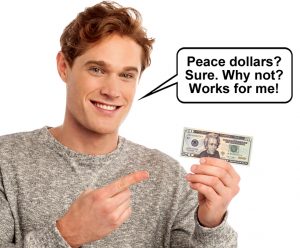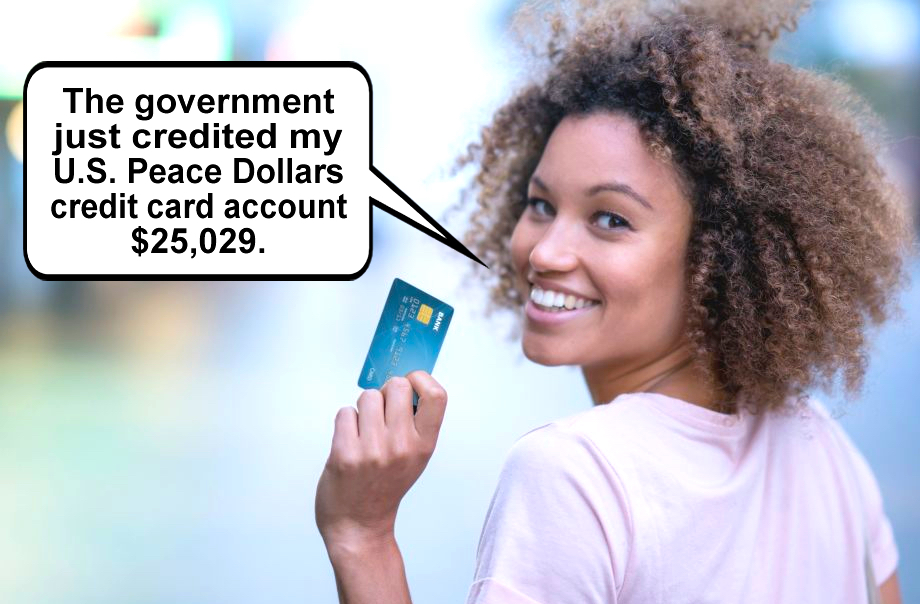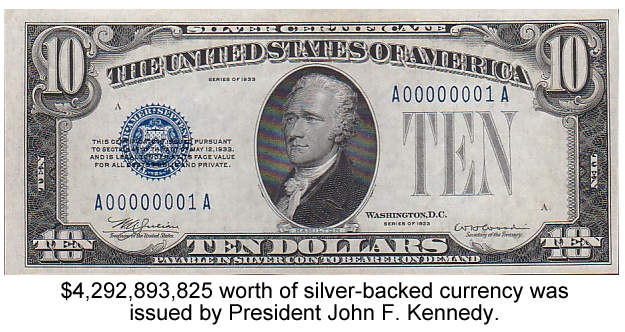Peace Dollars play a critical role in paying for the Peace Dividend refund. Let’s be clear exactly what’s being proposed.
Special use currency is not unprecedented.
Abraham Lincoln used “greenbacks” — the paper currency shown above, backed by nothing more than confidence in the government — to finance the Civil War. He printed $449,338,902 of this currency, a lot of money at the time.
A century later, on June 4, 1963, John F. Kennedy signed Executive Order 11110 which set in motion the issuance of silver certificate notes, currency backed by silver reserves being held at that time by the U.S. Treasury. Records show that Kennedy issued $4,292,893,825 worth of cash money. This bypassed the established procedure of borrowing money into circulation from the Federal Reserve. $20 billion of such United States Notes were eventually put into circulation before he was assassinated. It has been suggested it was Kennedy’s and Lincoln’s introduction of such interest-free debt-free currency which was the primary reason both of them were murdered.
Understand that their actions were completely within the framework of the Constitution. Of course, presidents must seek Congressional approval, as the ultimate authority for creating money actually resides with Congress. This is delineated in Article 1: The Legislative Branch, Section 8: Powers of Congress . . .
There is no dispute that what both Lincoln and Kennedy did, while anathema to private banking interests, was entirely legal. In fact, progressive economists would argue that it is incumbent on our elected officials to again secure absolute control of the currency, and that money creation never should have been ceded to the private banks.
Risk of assassination aside, no legal case or compelling argument can be made against using this power. Our current debt-driven system requiring us to borrow from the private banking institution, misleadingly named The Federal Reserve, to inject money into the economy is absurd and in the long term counter-productive.
While ultimately our goal should arguably be to totally eliminate the Federal Reserve’s role in this process, at least for now we can pick up where Kennedy left off, prudently using what we call U.S. Peace Dollars, to cover a sizable portion of the Peace Dividend budgeting requirements.
U.S. Peace Dollars would look almost exactly like their Federal Reserve Note counterparts. Same layout, same denominations, same founders-of-the-nation and presidential images.
Where U.S. currency now says … FEDERAL RESERVE NOTE
… U.S. Peace Dollars not surprisingly would say … U. S. PEACE DOLLARS
Where U.S. currency now says … IN GOD WE TRUST
… U.S. Peace Dollars would say … PROMOTING PEACE
Where in nearly microscopic print U.S. currency now says … THIS NOTE IS LEGAL TENDER FOR ALL DEBTS, PUBLIC AND PRIVATE
… U.S. Peace Dollars would say … THIS NOTE IS LEGAL TENDER FOR ALL DOMESTIC FINANCIAL TRANSACTIONS, PUBLIC AND PRIVATE
 Which brings up a critical feature of this financial instrument: U.S. Peace Dollars would be for domestic use only. This is to prevent them from being shipped overseas or being fed into the ongoing frenzy of currency speculation. Banks would be instructed to block transfer of U.S. Peace Dollars equivalencies to non-domestic banking institutions. For example, if a person deposited $8,000 of U.S. Peace Dollars into a domestic account, transfer of funds to non-domestic banks or use of funds for purchases outside the U.S. could only be made from balances of his or her account in excess of $8,000 accruing from regular Federal Reserve Note deposits.
Which brings up a critical feature of this financial instrument: U.S. Peace Dollars would be for domestic use only. This is to prevent them from being shipped overseas or being fed into the ongoing frenzy of currency speculation. Banks would be instructed to block transfer of U.S. Peace Dollars equivalencies to non-domestic banking institutions. For example, if a person deposited $8,000 of U.S. Peace Dollars into a domestic account, transfer of funds to non-domestic banks or use of funds for purchases outside the U.S. could only be made from balances of his or her account in excess of $8,000 accruing from regular Federal Reserve Note deposits.
This restriction is to guarantee that U.S. Peace Dollars go exclusively toward promoting America’s domestic economy, meaning only purchasing goods and services “Made in the USA”. This precludes exporting any newly generated Peace Dividend wealth, which would only exacerbate our already excessive, out-of-control trade deficit and facilitate capital flight from the country.
 Private banks would be incentivized to create U.S. Peace Dollars credit cards. If there is institutional resistance to this by private banks, the U.S. government can fill that need by issuing through its own agencies such credit instruments.
Private banks would be incentivized to create U.S. Peace Dollars credit cards. If there is institutional resistance to this by private banks, the U.S. government can fill that need by issuing through its own agencies such credit instruments.
A host of small-business and employee-owned business incentives could be built around U.S. Peace Dollars, for example giving matching federal grants or at least preferential treatment for investing U.S. Peace Dollars in job-creating domestic business start-ups. Worker-owned businesses and co-ops could be high on the priority list for such support. Activist organizations, community groups and individual activists who make significant contributions, ranging from creating safe, harmonious streets and neighborhoods to working for a peaceful world, could be targeted to receive grants and stipends to support their work. This is a way to divest from perpetual war and invest in peace and social justice.
All of this points the economy in a hopeful and highly constructive, new direction. Further expanding general usage of U.S. Peace Dollars down the road could gradually dismantle the current Debt Doomsday Machine of the Federal Reserve paradigm. Imagine Congress arguing over the size of budget surpluses instead of budget deficits!
Wouldn’t that be refreshing?







